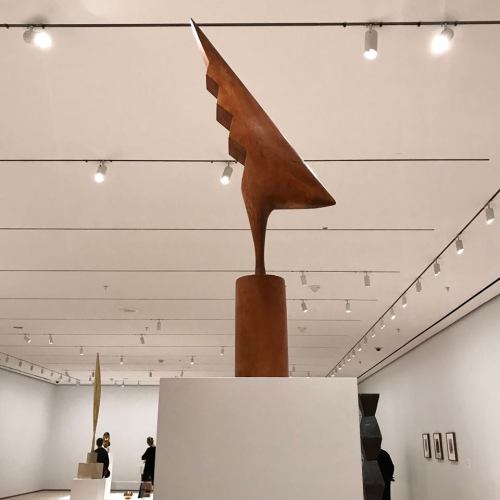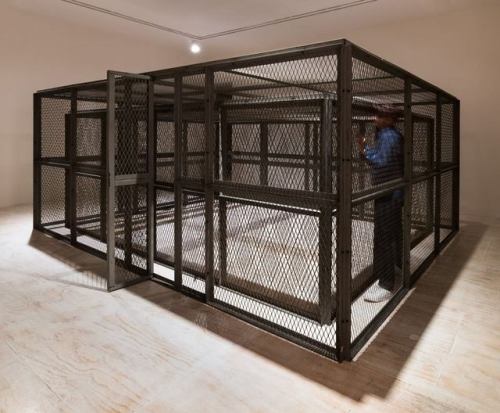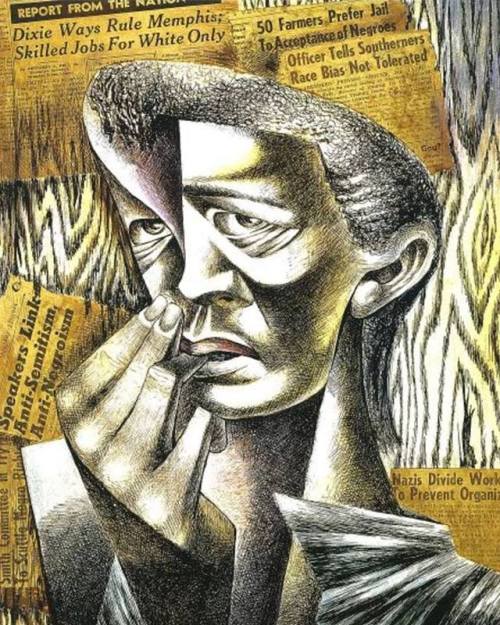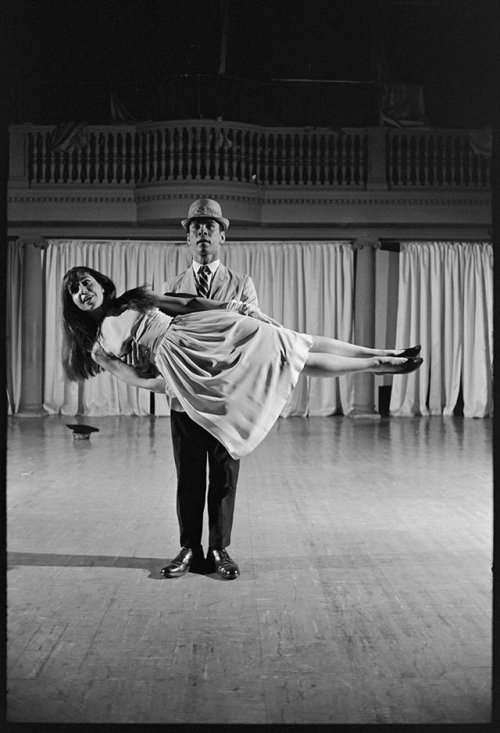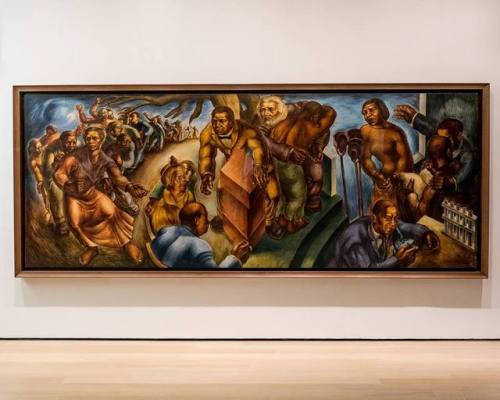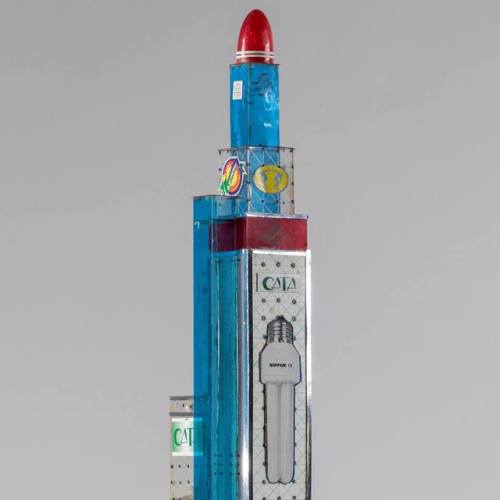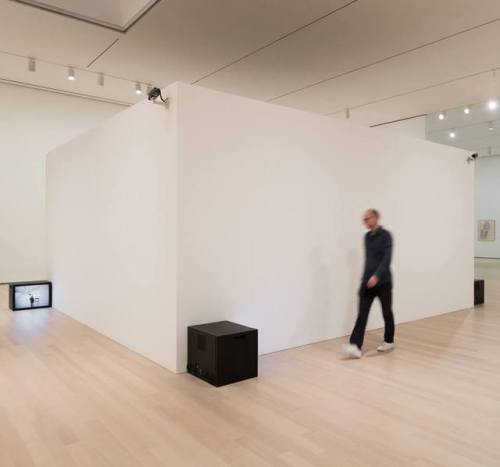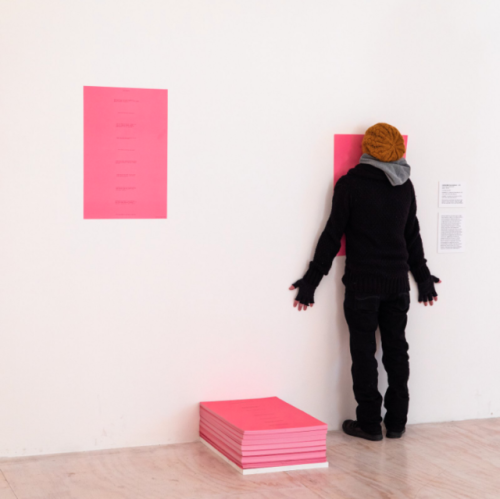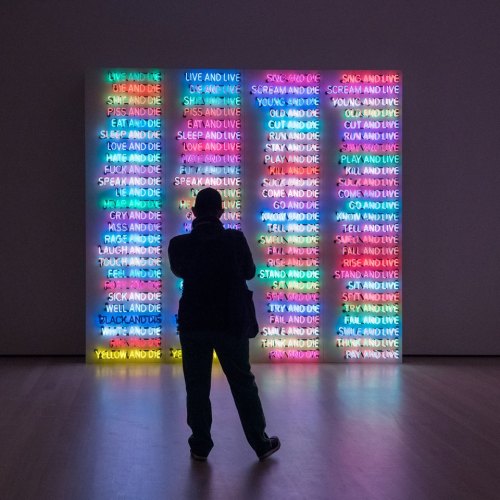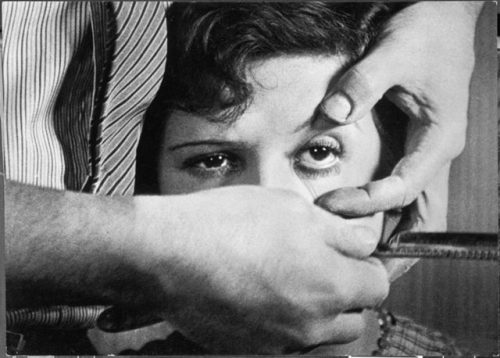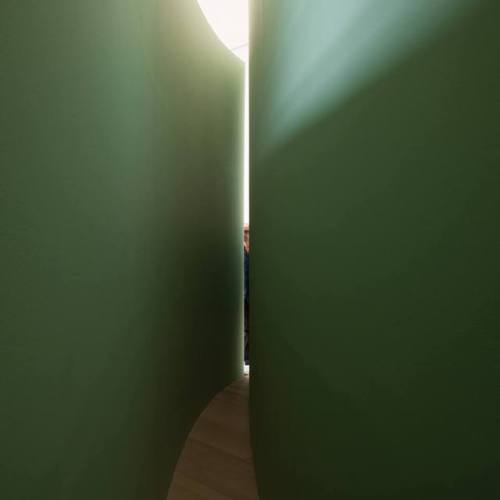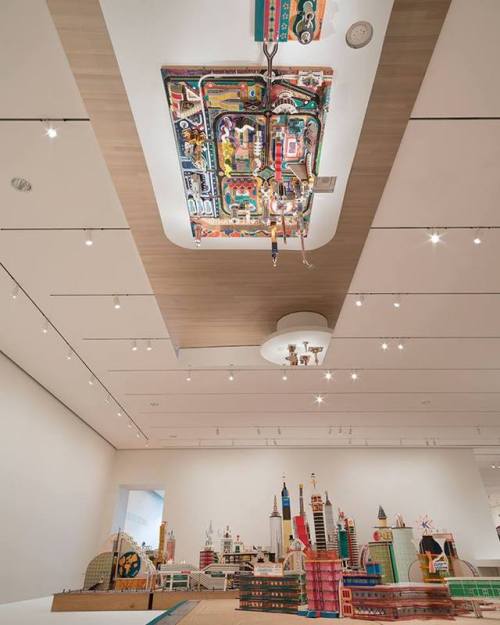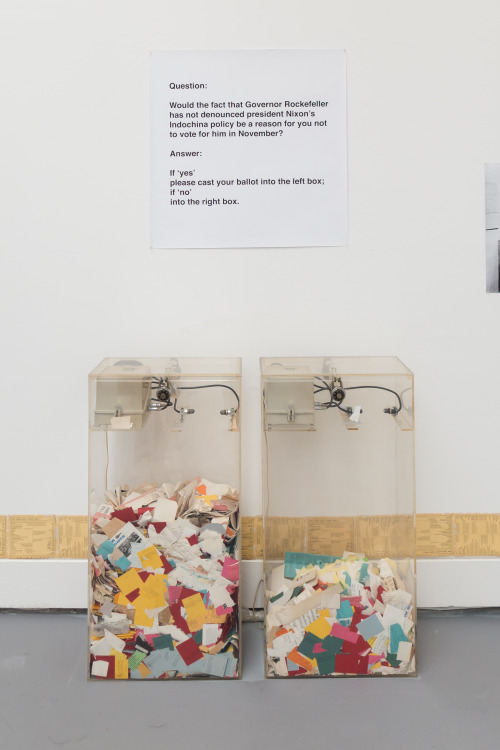#museum of modern art

John Marin was painting during an explosive time in New York. The city was expanding outward and upward at an unprecedented speed.
The Museum of Modern Art, New York.
Bruce Nauman: Clown Torture
Talking about the often self-humiliating nature of clown routines, #BruceNauman observed “You couldn’t get away with that without makeup. People wouldn’t put up with it, it’s too mean. But in the circus it’s okay, it’s still funny.” In “Clown Torture” (1987), now on view at MoMA PS1, the surveillance-style footage makes the viewer complicit with the distancing perspective of CCTV cameras. Will weallow ourselves to get away with spying on the clown as he desperately tries to fight off boredom while waiting to relieve himself?
…
[Credit: Bruce Nauman. “Clown Torture.” 1987. Four-channel video installation, two projections, four monitors, color, sound. The Art Institute of Chicago. Watson F. Blair Prize, Wilson L. Mead, and Twentieth-Century Purchase funds; through prior gift of Joseph Winterbotham; gift of Lannan Foundation. © 2019 Bruce Nauman/Artists Rights Society (ARS), New York]
Post link
Brancusi: View of the Artist’s Studio
Constantin Brancusi’s studio through the artist’s eyes—a closer look reveals his sculptures “The Kiss” in the background and “Mlle Pogany” in the foreground. Brancusi made fewer than 200 drawings, some of which depicted his studio, a subject that also appeared frequently in his photographs. In both his photographs and drawings, Brancusi shows his works stacked and layered in space. He often moved works from base to base, or placed them directly on the floor of his studio, so that they lived in the world alongside ordinary objects, and among people. Now on view.
…
[: Constantin Brancusi. “View of the Artist’s Studio.” 1918. Gouache and pencil on board. The Joan and Lester Avnet Collection. © Succession Brancusi - All rights reserved (ARS) 2018]
Post link
HOW TO SEE: Charles White
Missed our Charles White retrospective? Explore White’s technical prowess, his ability to depict “images of dignity,” and his groundbreaking collaboration with Harry Belafonte, alongside artist Toyin Ojih Odutola, exhibition curator Esther Adler, and MoMA staff, in our latest episode of HOW TO SEE.
#ArtSpeaks: Paulina Pobocha on Constantin Brancusi
“I really wanted to treat him as though he were a living artist.” –Paulina Pobocha, associate curator, shares how the curatorial team stayed true to how sculptor Constantin Brancusi wanted his work to be seen. Watch her gallery talk on selected works from our exhibition “Constantin Brancusi Sculpture.”
Constantin Brancusi Sculpture: The Cock
What do you think this work represents? If you guessed a rooster, you view the world a lot like sculptor Constantin Brancusi. Brancusi changed the course of sculpture forever with works that evoked “the essence of things” rather than serving as literal depictions. This simplified form and base, now on view, was carved from a single piece of wild cherry wood.
…
[Credit: Constantin Brancusi. “The Cock.” Paris 1924. Cherry. Gift of LeRay W. Berdeau. © Succession Brancusi - All rights reserved (ARS) 2018]
Post link
Concrete Utopia: The Monument to the Revolution on Mount Kozara
The Monument to the Revolution on Mount Kozara, designed by Dušan Džamonja from 1970-72, evokes the harrowing experience it was built to commemorate—an intense 1942 battle where Axis troops laid siege to Communist-led resistance units and local civilians. Visitors enter through slits in the tower’s concrete fins to a dark, cramped interior space where light penetrates through an opening at the top, accentuating the tense atmosphere. Explore Towards a Concrete Utopia:mo.ma/concreteutopia
…
[Photo: Selma Banich (Flickr) [Public domain], via Wikimedia Commons]
Post link
Charles Atlas on Judson Dance Theater
Artist and filmmaker Charles Atlas arrived in New York shortly after the heyday of Judson Dance Theater, and set out to build on and challenge their expanded notion of dance. “When it came to do my own work, I was looking for another way to go… Every generation does something different from the generation before,” he says. Together with Merce Cunningham, Atlas developed “video dance”—works created directly for and incorporating movements of the camera—before going on to have an acclaimed career in his own right.
Atlas reflects on his Judson Dance Theater installation, now on view in our Marron Atrium, and what it was like to revisit Judson’s history in a new interview: mo.ma/atlasonjudson
…
[Video: Installation view of the exhibition, “Judson Dance Theater: The Work Is Never Done” at MoMA]
#ArtSpeaks: Nectar Knuckles on Charles White
“That’s a really unique ability…to look at a work of art and feel it seeing you. And in this room, I feel seen.” –Nectar Knuckles, a curatorial fellow in our Department of Drawings & Prints, shares how it feels to enter the #CharlesWhite galleries at the Museum. Watch her full gallery talk on “Spiritual” (1941).
Concrete Utopia: Jasenovac Memorial Complex
After World War II, Yugoslavia memorialized its fight against Axis powers, and the millions of wartime casualties suffered, with monuments like this one on the site of a razed concentration camp in Jasenovac, Croatia. The “Stone Flower” serves as a grave marker and an expression of a desire to unify the multiethnic country by demarcating its territory after the war with sites of collective remembrance. Explore Concrete Utopia.
…
[Bogdan Bogdanovic. “Jasenovac Memorial Complex.” 1959-66. Photo: Valentin Jeck, commissioned by The Museum of Modern Art, 2016]
Post link
Bruce Nauman: Poke in the Eye/Nose/Ear 3/8/94 Edit
Nauman’s own body is a sculptural material that is prodded in slow motion in this early video. Now on view at MoMA PS1 as part of Bruce Nauman: Disappearing Acts, the first comprehensive retrospective of the artist’s work in over twenty years, spanning both MoMA and MoMA PS1. Plan a visit for in-depth insight into the diverse facets of his work across fifty years.
…
[Credit: Bruce Nauman. “Poke in the Eye/Nose/Ear 3/8/94 Edit.” 1994. One video projector, one video player, one video source (color, sound). © 2018 Bruce Nauman/Artists Rights Society (ARS), New York.]
#ArtSpeaks: Wenxiao Li on Mark Rothko
“This dimensional sensation just roused me out of the depression that I had at that time…and I realized there’s a slight chance that Mark Rothko is going through the same emotional journey as I did.”
–Wenxiao Li, a guest assistant at the Museum, shares how seeing Rothko’s work in the Museum galleries helped her navigate the emotions that come with moving to a new country. Watch her gallery talk on “No. 16 (Red, Brown, and Black)” (1958).
Bruce Nauman: Double Steel Cage Piece
Now at MoMA PS1: Many of Bruce Nauman’s architectural works are claustrophobia-inducing spaces that viewers can enter. In “Double Steel Cage Piece” (1974), you traverse a very narrow passage within and around a cage while others watch — a doubly uncomfortable experience.
…
[Image: “Double Steel Cage Piece.” 1974. MoMA PS1. © 2018 Bruce Nauman/Artists Rights Society (ARS), New York. Photo: Martin Seck]
Post link
#ArtSpeaks: Pablo Helguera on Giorgio de Chirico
Italian artist Giorgio de Chirico’s captivating dreamscapes occupy a room of their own in our collection galleries. Pablo Helguera, our director of Adult and Academic Programs, shares de Chirico’s view of the world as “a museum of strange things.”
Charles White: Headlines
“…that was the impact Charles White had on you. You should always be engaged with history. You should always be engaged with the politics of your time. And if you’re not doing it directly, certainly to always make sure that was present in people’s consciousness, that they understood something about history. And that your work should be in the service of helping to dignify people.” –Kerry James Marshall on his former teacher and mentor Charle White
…
[Credit: Charles White. “Headlines.” 1944. Ink, gouache, and newspaper on board. Collection of William M. and Elisabeth M. Landes. © The Charles White Archives]
Post link
Studio Visit: Firelei Báez
“…how do you make someone present when history has made such an effort to erase them?… I want there to be room for the viewer to recreate her in the present along with me. That’s why the only fixed point in each portrait is their direct gaze, connecting them to the viewer.”
Artist Firelei Báez’s work “For Améthyste and Athénaire (Exiled Muses Beyond Jean Luc Nancy’s Canon), Anaconas” is our newest Modern Window installation, located at the Museum’s 53rd Street entrance. Read more about her work to reclaim the stories of marginalized Afro-Latina and Afro-Caribbean women.
…
Photo: Rose Liu
Post link
Judson Dance Theater
“Judson is come in whatever you need we’re gonna try to give it to you. You will need a shower, come here. There’s a shower, there’s a toilet, there’s a place to eat your lunch. You want to practice, there’s a place to practice. You know the thing about those guys is, well, they believed in us, and they believed in the world.” –Aileen Passloff, reflects on Judson Memorial Church in our Judson Dance audio guide on mo.ma/judsondance
The workshops in the basement of church were developed by the Judson group into performances that were presented in a series of sixteen free concerts between 1962 and 1964. Concerts took place all over the church, from the basement to the altar. In the sanctuary, pews would be cleared out after Sunday services to make way for the dancers.
…
[Credit: Al Giese’s photograph of Rudy Perez and Elaine Summers in Perez’s Take Your Alligator with You. Performed at Concert of Dance #7, Judson Memorial Church, June 24, 1963. © Estate of Al Giese/Licensed by VAGA, New York, NY.]
Post link
Concrete Utopia: Monument to the Battle of the Sutjeska
Yugoslavia’s monuments became fruitful ground for architectural experimentation. In Concrete Utopia we explore the Monument to the Battle of the Sutjeska commemorating a 1943 battle that marked the turning point for the country in World War II. Two abstract, jagged concrete masses face one another to simulate the landscape of the surrounding mountain gorge where the combat took place.
…
[Miodrag Živković. Monument to the Battle of the Sutjeska. 1965–71, Tjentište, Bosnia and Herzegovina. Photo: Valentin Jeck, commissioned by The Museum of Modern Art, 2016]
Post link
#ArtSpeaks: Rose Liu on Joan Jonas
“That’s how our brains function. We think of several things at the same time….In a way, her work represents that way of seeing the world.“ –Intern Rose Liu shares the work that made her fall in love with video art.
…
#ArtSpeaks is a day of community and conversation led by Museum staff on the last Tuesday of every month. Watch Rose’s full gallery talk on Joan Jonas’s “Reanimation” (2010/2012/2013) on our Facebook page at mo.ma/2OFIEpr
Q&A with MoMA Exhibition Designers
How does an exhibition take shape at The Museum of Modern Art? Tune in to learn how MoMA’s Exhibition Design team works with artists and curators to transform galleries for each new show.
Charles White: Five Great American Negroes
Charles White’s first mural “Five Great American Negroes”—painted when he was just 21 years old—comes to New York thanks to a historic loan from Howard University. Created in Chicago as part of a fundraiser for the South Side Community Art Center, the “great Americans” depicted were chosen by readers of the Chicago Defender, a major black newspaper. Can you name all five?
Like many American artists, White was influenced by Mexican muralists like Diego Rivera and adapted their strategies for educating and inspiring viewers. White would produce three more murals between 1939 and 1943. Their public placement perfectly suited his lifelong goal of promoting African American history to combat what he called “a plague of distortions” in popular visual culture.
…
[“Photograph of Charles White working on ‘Five Great American Negroes’ (1939).” 1939. Gelatin silver print. The Museum of Modern Art Archives, New York; Charles White. “Five Great American Negroes.” 1939. Oil on canvas. From the Collection of the Howard University Gallery of Art, Washington, D.C. © The Charles White Archives. Photo: Austin Donohue]
Post link
Bodys Isek Kingelez: Nippon Tower
Take a closer look at Nippon Tower (2005) in Bodys Isek Kingelez: City Dreams and you’ll see a quirky combination of found objects—a plastic Smint box, a milk carton, BIC razor blades, and lightbulb boxes, and a playfully shaped plastic spoon. This work can perhaps be understood as a portrait of the Congolese artist through his materials—the brands he may have favored, and what he had on hand in his studio at the time. The soaring tower represents the increasingly unorthodox approach Bodys Isek Kingelez took in his later years. Now on view.
…
[Credit: Bodys Isek Kingelez. “Nippon Tower.” 2005. Paper, paperboard, plastic, and other various materials. Courtesy Aeroplastics Contemporary, Brussels. © Bodys Isek Kingelez. Photo: Vincent Everarts]
Post link
Charles White: Beyond Images of Dignity | MoMA LIVE
Join artist Kerry James Marshall for a conversation on the technical virtuosity, visual strategies, and changing reception of the work of his former teacher and mentor Charles White.
“What interested me was the idea that…You don’t try to avoid the resistance. You go straight to it, try to analyze the parts that make you uncomfortable… and then certain physical blocks will be released.” –Bruce Nauman
Bruce Nauman’s invitations to participate in artwork, like the enticing surveillance of “Going Around the Corner Piece” where visitors who pace the perimeter of a sealed room catch glimpses of themselves from behind as they approach its surrounding monitors—now on view at MoMA—turn passive viewers into performers. Will you join in?
[Credit: Installation view, “Going Around the Corner Piece” (1970) in “Bruce Nauman: Disappearing Acts” at MoMA. © 2018 Bruce Nauman/Artists Rights Society (ARS), New York. Photo: Martin Seck]
Post link
“For me, this piece is serving as a reminder, not only of a past to be remembered, but also a future to be fought for.”
–Fellow Devin Malone shares common histories and hauntings with artist Charles White. Watch her gallery talk on White’s Mississippi(1972) →
…
#ArtSpeaks is a day of community and conversation led by Museum staff on the last Tuesday of every month. Learn more at mo.ma/artspeaks
“This may become a very erotic exercise…"
Many of Bruce Nauman’s works invite direct participation. Body Pressure (1974) is a call for extreme bodily awareness, incomplete without your cooperation. Now on view at MoMA PS1 in Disappearing Acts: mo.ma/brucenauman
[Credit: Installation view, “Body Pressure” (1974) in "Bruce Nauman: Disappearing Acts” at MoMA PS1. © 2018 Bruce Nauman/Artists Rights Society (ARS), New York. Photo: Walter Wlodarczyk]
Post link
What does Charles White sound like?
For WQXR host Terrance McKnight, it’s a medley ranging from soul and blues singers—and Charles White subjects—like Bessie Smith and Mahalia Jackson, to the concert hall music of George Walker and Handel. Working with Museum curator Esther Adler, McKnight developed a playlist for our Charles White exhibition, pairing songs, poetry, and political speeches with the artworks on view.
“I wanted people to take three to five minutes to meditate on these images…to walk away with more empathy and more appreciation of the beauty of what [White] did and what was important for him,” said McKnight. Listen to the exhibition playlist and learn more about McKnight ‘s exploration of the relationship between visual art and music: mo.ma/charleswhitesound
…
[Artwork: Charles White. “Bessie Smith.” 1950. Tempera on panel. Private collection. © The Charles White Archives]
Post link
“Disappearing Acts lets us see with clarity where the artist stands and why he is pertinent to our wrenching moment…. It’s a transfixing trip.”
The New York TimesreviewsBruce Nauman: Disappearing Acts, now on view at MoMA and MoMA PS1. Read more →
…
[Installation view, “Bruce Nauman: Disappearing Acts” at MoMA, New York (October 21, 2018–February 25, 2019, at MoMA and MoMA PS1). © 2018 Bruce Nauman/Artists Rights Society (ARS), New York. Digital image © 2018 The Museum of Modern Art, New York. Photo: Martin Seck]
Post link
MoMA Picks: Artist Collaborations
“I love dreams, even when they’re nightmares, which is usually the case…. ‘Un chien andalou’ was born of the encounter between my dreams and [Salvador Dalí]’s.” –Luis Buñuel
Submitted by our editorial manager, Jason Persse. Explore more #MoMApicks of our staff’s favorite artist collaborations in the Museum’s collection: mo.ma/picks
…
[Artwork details: Luis Buñuel, Salvador Dalí. “Un Chien Andalou.” 1928. 35mm film (black and white, silent). Gift of Luis Buñuel]
Post link
“That not everyone can get in but can (attempt to) watch is important. It’s a moral dilemma that gives weight to the whole” – Bruce NaumanonKassel Corridor: Elliptical Space (1972), now on view for the first time in New York at MoMA.
Whether making viewers decide whether to watch or be watched or vanishing the binaries of moral clarity, as seen in Seven Virtues/Seven Vices, now on view at MoMA PS1, Nauman’s work erases all forms of certainty, requiring us to craft our own meanings rather than adhere to established rules.
[Image Credits: Installation view, Kassel Corridor: Elliptical Space (1972) in Bruce Nauman: Disappearing Acts at MoMA, New York (October 21, 2018–February 25, 2019, at MoMA and MoMA PS1). © 2018 Bruce Nauman/Artists Rights Society (ARS), New York. Photo: Martin Seck
Bruce Nauman. Seven Virtues/Seven Vices. 1983-84. Limestone, in seven parts. Gift of Edward R. Broida. © 2018 Bruce Nauman/Artists Rights Society (ARS), New York]
Post link
“First comes the name (the title) of the piece; secondly I wait for the vision to come; then I make it real. I never make preliminary drawings. The vision gives me all I need, even the shape and the colors….I am a designer, an architect, a sculptor, engineer, artist.” –Bodys Isek Kingelez
Step inside visionary Congolese artist Bodys Isek Kingelez’s utopian vision for the cities we live in: mo.ma/kingelez
…
[Installation view of “Bodys Isek Kingelez: City Dreams,” The Museum of Modern Art, New York, May 26, 2018–January 1, 2019. © 2018 The Museum of Modern Art. Photo: Denis Doorly]
Post link
Now on View: Charles White: A Retrospective
“An artist must bear a special responsibility. He must be accountable for the content of his work. And that work should reflect a deep, abiding concern for humanity.” –Charles White
SOUND ON: Hear performer and activist Harry Belafonte introduce his friend, influential artist and teacher Charles White. White dedicated himself to creating art that exposed the lives of African Americans and the hardships of oppressed peoples everywhere with inventive experimentation across mediums. Explore his prolific four-decade career in “Charles White: A Retrospective,” now on view at the Museum thanks to the support of Terra Foundation for American Art.
#ArtSpeaks: Tunji Adeniji on Frida Kahlo
Whenever Frida Kahlo’s works are moved in the Museum, our chief facilities and safety officer Tunji Adeniji makes sure he knows exactly where they’re located. Watch his gallery talk on “My Grandparents, My Parents, and I (Family Tree)” (1936) to find out why the artist means so much to him: mo.ma/2yIERlr
#ArtSpeaks is a day of community and conversation led by Museum staff on the last Tuesday of every month.
#MoMApicks: “AIDS (Wallpaper detail).”
“In the mid-1980s, the Canadian art group General Idea (AA Bronson, Felix Partz, and Jorge Zontal) created a symbol using the acronym AIDS, arranging the letters in a manner that resembled Robert Indiana’s iconic LOVE motif in the form of billboards, stamps, wallpaper, and other prints. The group called it an ‘image virus.’” –Roxana Marcoci, senior curator in our Department of Photography
Explore more of our staff’s favorite#MoMACollection artist collaborations atmo.ma/picks
…
[Details: General Idea. “AIDS (Wallpaper detail).” 1988. Screenprinted wallpaper. Gift of Richard Gerrig and Timothy Peterson in celebration of the Museum’s reopening. © 2018 General Idea]
Post link


A.F. Vandevorst installation for Arnhem Mode Biennale 2011
“A girl sleeping in a hospital bed in her A.F. Vandevorst dress. But here, the girl as well as the mattress and pillow are made out of candle wax. Once lit, what starts as a perfect image will slowly melt and perish during the biennale.”




